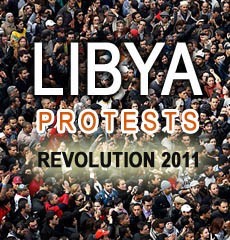The Libyan Revolution took the form of Nationwide protests which started on the 15th of January 2011, before turning into armed confrontations.
In just a few days, opposition forces took control of many Libyan cities specifically Benghazi which is located towards the northern east side of Libya. This came right after the protests in Egypt were proving to be very fruitful.
See also Arab Revolutions.
Protagonists and Leading Participants in the Libyan Revolution
Political activists, but mostly just the regular people started the first manifestations. Enver Bey, a leading member of the Leadership Council of the Libyan Revolution was also in support of the revolution. Ibrahim Jibril was a special guest on Al Jazeera TV and also played a big role in clarifying the situation on the ground.
Young internet activists, such as Mohammad Nabbous, played an important role is showing the world what was happening on the ground.
Exiled activists such as Fathi al-Warfali, Faiz Jibril or even the deputy secretary general of the National Front for the Salvation of Libya Mohammed Ali Abdallah, were also on the alert.
On the ground in Libya, activists such as Abdel Hafez Gougha helped organize the protests and communicate the plans to supporters of the Libyan opposition.
Main Slogans and Demands
The demands were high early on, and specifically asked for the departure of Gaddafi.
Progression and Outcome
The 2011 Libyan protests began as a series of demonstrations and confrontations which took place mainly in the North area of Libya against the 42 year regime of Muammar Al Gaddafi. Soon after the nationwide protests, armed revolt and occupation of cities became necessary to reppel the attacks of Gaddafi’s militia and African mercenaries.
Gaddafi had been carefully following the events in Tunisia, and had even expressed his support of Zine El Abidine Ben Ali. He had even addressed the Tunisians assuring them he was the best president they would ever get. He also learned the importance of media and the effect it had in supporting previous protests, this is why Libyan Interference jammed Lebanese satellite news channels to restrain coverage.
The protests began on 15 February 2011 and escalated into a major protests and clashes by the end of February.
The unrest was attributed to the domino effect of the situation in neighboring countries like Tunisia Protests and Egypt Protests.
The protests of February lead to the formation of a Benghazi National Transitional Council.
In the mid month of March 2010, the NATO comprising of the world leaders, decided to apply a no Fly-Zone over Libya in an attempt to paralyze the Ghadafi power and give freedom to the people of Libya.
On 20 March, The UK, US and France attacked Libyan leader Col Muammar Gaddafi’s forces in the first action to enforce the UN-mandated no-fly zone.
The US and the UK fired more than 110 missiles, while French planes struck pro-Gaddafi forces attacking rebel-held Benghazi.
Just like other Arab countries, many people were against that move and saw in this another Iraq and land domination by the world leaders. Other groups, especially the opposition, saw in the NATO support a ray of hope into a future free of the Gadaffi control.
On the 19th of March 2011, Journalist Mohammad Nabbous, founder of Libya AlHurraTV was killed the dictator forces in Libya.
Casualties & Death Toll in Libya Protests
One of the most costly revolutions in the area with approximately 6,000–10,000 martyrs so far.
Popular Anecdotes and Observations in Libyan Revolution 2011
Many stories surrounding Gaddafi’s bizarre practices started to emerge, and ex body guards such as Aziza Ibrahim gave interviews about such matters. Scandals related to his son and his wife Aline Skaf also became popular again.
Rumors that Imam Moussa El-Sader is still alive in Liyba also resurfaced.
